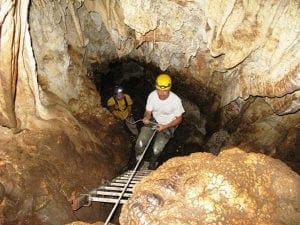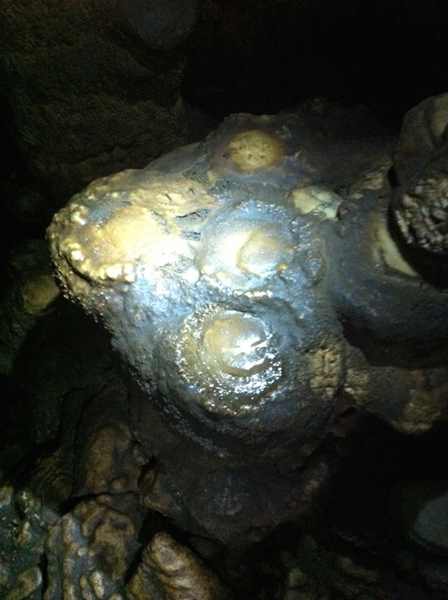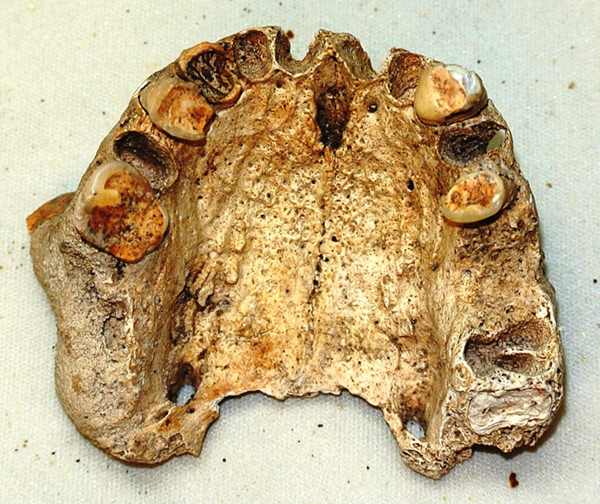
Cool Places – Going Deep at Barra Honda
There’s an unwritten rule that all adventures in Costa Rica have to be a little bit scary, and so it is with visiting the spectacular Terciopelo Cave at Barra Honda National Park.
In the U.S., there would probably be an elevator. Here there’s a 56-foot aluminum ladder attached vertically to an underground cliff. It’s the only way in and the only way out.
You’ll be harnessed, helmeted and roped, of course, and any fool can climb down a ladder — but picture a ladder that is straight up and down, and you have to start at the top of a 5-story building. This is not for the faint of stomach, and you may be drenched in sweat by the time you reach the bottom.

A visit to Caverna Terciopelo starts with descending a 56-foot ladder. Credit: Grupo Espeleológico Anthros
Caverna Terciopelo is the centerpiece of Barra Honda, the only national park in Costa Rica created to protect caves. Some 42 caves have been discovered here, but only 19 have been explored, and only this one and a small cave for children are open to the public. The others are filled with bats whose guano can cause life-threatening lung disease.
Terciopelo is filled with stalactites, stalagmites and columns that resemble ordinary things — a mother hen and her chicks, a papaya, a family, grapes, teeth, and “el organo,” which is hollow and makes different notes when tapped in different places, like an organ.
In the back of this main room there is another ladder to a lower part, but it’s short and it actually leans, so no ropes are needed. This will take you to the Fried Eggs Room, named for a hardened puddle in the middle that looks like a pan of huevos fritos.
There’s even one brown stalagmite that looks like a dark, robed woman — and is known as La Negrita, Costa Rica’s patron saint, after the legendary statue in the Basilica of Cartago.
At one point your guide will have your group turn off all the lights and soak in the sensation of total darkness and the total absence of sound.
This entire mountain was originally a coral reef in the ocean that once separated North and South America, and you can still see fossilized coral on the wall. Perhaps 70 million years ago, Barra Honda rose above sea level because of tectonic plate shifts, and the coral died and became limestone.
Rainwater fell and combined with carbon dioxide as it seeped into the soil, and it turned into a mild carbolic acid that over millions of years dissolved and eroded the interior of the chalky mountain, creating the caves.
Since the early 1900s, locals were aware of deep holes in the ground where you could drop a rock and barely hear it hit the bottom. They could also hear a rumble inside (which turned out to be bats), and they assumed that these were volcanic craters.
The caves were not explored, at least in modern times, until 1967, when spelunkers with mountaineering equipment began entering what turned out to be the largest network of caves in Costa Rica.
Imagine their surprise when they found the remains of six human beings in a cave called Nicoa. They are thought to be Chorotega nobles who were buried here close to 2,000 years ago. Archaeologists theorize that Nicoa was originally filled with water, and that the Chorotega would burn their dead and float their remains on a raft into the cave because it was thought to be a gateway to the afterlife.
Carlos Goicoechea, a founding member of the Anthros Speleological Group, was one of two people who first discovered Terciopelo in 1968. At the bottom they found a dead rattlesnake, but he mistook it for a terciopelo, a fer-de-lance, and that’s how the cave got its name.
“We had a fever,” he said. “We were like 15 to 20 people with very limited resources, and we would all go in a Volkswagen, five people with all the gear on top and up front and on the back, and the road to Guanacaste was dirt. The trip took nine to 10 hours. We had to take a gallon of water each, or more. From 1967 to about 1973, we worked very hard, and the park was created in 1974. We had a lot to do with that.”
Barra Honda National Park is about 30 minutes from the city of Nicoya. In addition to the caves, the 2,997 hectares of dry tropical forest here contain a significant number of birds, reptiles, amphibians and mammals (half of which are bats).
Good walking trails abound, and there is a great mirador, a lookout called Nacaome, with a spectacular view of the yellow and green plains below and the Gulf of Nicoya in the distance.
IF YOU GO
Hours: Cave tours are conducted from 8 a.m. to 1 p.m. every day, and the park is open for hiking until 4 p.m.
Getting there: Buses do not travel to Barra Honda, but you can take a bus to Nicoya and hire a taxi for about $24. (One bus can also drop you off 1km from the Barra Honda entrance.) With your own car, take Highway 21 east from Nicoya and follow the brown signs to Parque Nacional Barra Honda.
Admission: Entering the cave costs $29 for foreigners and $19 for nationals, and you must pay cash.
What to bring: Closed-toed shoes — you cannot enter the cave in flip-flops.


